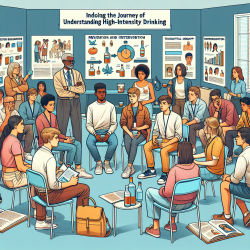Understanding High-Intensity Drinking: A Guide for Practitioners
High-intensity drinking (HID), defined as consuming 10 or more drinks in a row, poses significant public health risks. The recent study titled "Prevalence of High-Intensity Drinking from Adolescence through Young Adulthood: National Data from 2016-2017" sheds light on this pressing issue. This blog aims to help practitioners leverage these findings to enhance their intervention strategies.
Key Findings from the Study
The study utilized data from the Monitoring the Future survey, encompassing responses from U.S. students in grades 8, 10, and 12, and follow-up data from 12th graders into young adulthood. Here are some critical insights:
- HID prevalence ranged from 1% at age 14 to 11.5% at ages 21/22, highlighting a significant increase during late adolescence and early adulthood.
- Sex differences were notable, with males reporting higher HID prevalence than females from ages 16 through 30.
- Binge drinking (5+ drinks in a row) was more common, with prevalence peaking at 32.5% at ages 21/22.
Implications for Practitioners
The data underscores the need for targeted prevention and intervention strategies. Here’s how practitioners can apply these findings:
- Focus on Early Intervention: The sharp increase in HID from adolescence to young adulthood suggests the importance of early intervention. Programs targeting students before age 14 could help mitigate future HID behaviors.
- Gender-Specific Approaches: Since males exhibit higher HID prevalence, interventions should consider gender-specific strategies to address these differences effectively.
- Education and Awareness: Educating adolescents about the risks associated with HID, such as alcohol poisoning and risky behaviors, can be a vital component of prevention efforts.
Encouraging Further Research
While this study provides valuable insights, it also highlights areas for further research. Understanding the underlying factors contributing to sex differences in HID and how these factors evolve over time could enhance intervention strategies. Additionally, exploring the role of social and cultural influences on drinking behaviors may offer new avenues for prevention.
To read the original research paper, please follow this link: Prevalence of High-Intensity Drinking from Adolescence through Young Adulthood: National Data from 2016-2017.










